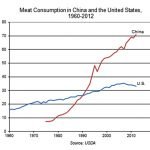Enlightened shoppers know to check nutrition fact labels before sticking a food item in the cart, but the information reported on the labels has long been limited and even somewhat deceptive. Now, for the first time in 20 years, the FDA has decided to do something about it and has recently released new guidelines for the Nutrition Facts panel.1 Cha, Ariana Eunjung and Thompson, Krissah. “Food labels to get first makeover in 20 years with new emphasis on calories, sugar. 27 February 2014. Washington Post. 13 March 2014. http://www.washingtonpost.com/national/health-science/food-labels-to-get-first-makeover-in-20-years-with-new-emphasis-on-calories-sugar/2014/02/26/c8feeb4c-9f08-11e3-9ba6-800d1192d08b_story.html On the one hand, the proposed revisions give cause for celebration since they definitely represent an improvement in letting customers know just what they’re buying. On the other hand, they still won’t tell the whole story about what’s in the package.
The good news includes the fact that the calorie information will now be much bigger and bolder, so you don’t need to adjust your bifocals to read it. In fact, it appears that it will be five or six times larger and bolder than the calorie information now on labels. The rest of the label will continue to be in small print, but it will be less cluttered. The calorie information will be at the top of the chart, set off by dark bars above and below it, so it will be hard to miss if you’re half looking for it.
And, by the way, it turns out that an increasing number of Americans are looking. A study in 2010 by the Department of Agriculture found that 42 percent of consumers check nutrition labels when they shop. That’s an eight percent increase from 2008, so it seems that shoppers continue to get savvier…sort of. Unfortunately, as we’ve discussed previously, calorie counting is too abstract for most people to elicit any change in behavior.
Another proposed change that’s perhaps even more significant is that the portion sizes will be adjusted to represent the amount of the food item that consumers actually eat. For instance, right now, the standard serving size reported on ice-cream cartons is half a cup. When you buy Haagan Dasz chocolate chocolate-chip, you may consult the label and notice that the ice cream contains 300 calories per serving, and that includes 20 grams of fat, 12 of which are saturated. Again, those figures are based on the assumption that a serving will consist of half a cup. But let’s get real. It’s unlikely that you’ll only eat a small scoop. A cup is more realistic, and that’s if you show restraint. And so, for you (and for most people) a serving actually contains at least 600 calories and 24 grams of saturated fat. Most consumers don’t bother to do the math.
The new guidelines will now specify that a serving of ice cream is one cup, and the 600 calorie load will have to be broadcast in bold. Similarly, muffins will now be considered one serving instead of two (who knew?); breakfast cereal will be evaluated on the basis of a serving being a cup rather than a ½ or ¾ of a cup; and frozen entrees will be reported as a single serving.2 Associated Press. “New Food Labels Aim to Make Healthy Shopping Easy.”27 February 2014. NPR. 13 March 2014. http://www.npr.org/templates/story/story.php?storyId=283254352 Canned beverages, whether they are 12 ounces or 20 ounces, also will be considered a single serving, given that people usually drain the entire can. In some cases, such as for bags of chips, the label will report information for both a serving as well as for the entire package.
There’s also going to be more detailed information about how much added sugar the product contains. Currently, labels report the total amount of sugar in a product, but that includes both natural and added sugars. Many foods such as fruit contain a substantial amount of sugar in their natural form, but the major health concern comes from the extra sugar that’s added in the form of corn syrup, sucrose, and so on. The new guidelines specify that the added sugar sources be differentiated, since added sugar poses far more of a health threat than the sugar inherent in foods. Plus, vitamin D content as well as potassium content will be reported.
Some health advocates say the changes don’t go far enough. In some countries in Europe, nutrition facts appear in bold print on the front of the package, and that’s what the Institute of Medicine recommends. The European system also makes use of a star-rating system, a color-coding system, and numerical ratings so that consumers can see at a glance how healthy a product is, or is not.
But even if the FDA moves to display the label on the front, the new measures still leave out key information. There’s no provision for showing the percentage of daily recommended sodium the product contains, for instance. And the guidelines don’t require that GMO foods be identified as genetically modified or that they contain GMO ingredients. They don’t require that cans with BPA linings be labelled as such. There’s no way of knowing what chemicals the food got sprayed with–although the chances of that ever being revealed on the package are about two billion to one. And the ingredient list, which often is in such tiny print that it’s near impossible to read, can remain microscopic.
Still, the move does represent an improvement, though none of the proposed changes are finalized. The FDA will be accepting comments on the proposed changes for the next 90 days. Experts project that the final changes will be approved in about a year. After that, it could be several more years before the new guidelines get implemented. In the meantime, you’ll do well to avoid processed food when possible, and when you must use something that comes with a label, read carefully.
References
| ↑1 | Cha, Ariana Eunjung and Thompson, Krissah. “Food labels to get first makeover in 20 years with new emphasis on calories, sugar. 27 February 2014. Washington Post. 13 March 2014. http://www.washingtonpost.com/national/health-science/food-labels-to-get-first-makeover-in-20-years-with-new-emphasis-on-calories-sugar/2014/02/26/c8feeb4c-9f08-11e3-9ba6-800d1192d08b_story.html |
|---|---|
| ↑2 | Associated Press. “New Food Labels Aim to Make Healthy Shopping Easy.”27 February 2014. NPR. 13 March 2014. http://www.npr.org/templates/story/story.php?storyId=283254352 |











